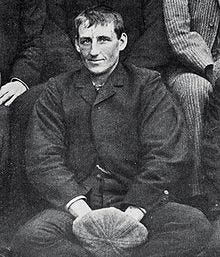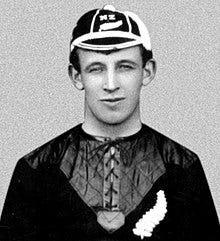George Tyler may have been the most acidic critic of the side, but not all former All Blacks and other members of The Originals of 1905-06 felt so negatively ahead of the 1924-25 tour.
The try-scoring star of the Originals, Jimmy Hunter, whose record of 44 tries will never be headed, was not a player who has been especially prominent in media interviews. But, in speaking about the 1924-25 side, although he didn't think they would beat the 1905-06 team's record, he felt they could develop into a good combination.
Jimmy Hunter - try scorer galore for 1905-06 Originals
The odds against that are too great. Even should they be better than all they meet, they are bound to get caught napping sometime. There is a good deal of luck in the game. Some of the best may be put out of action by accidents or illness. Then English Rugby is said to have greatly improved of late years. I feel sure that we are sending away a team that we will be proud of, on and off the field.[1]
Hunter recalled a severe scrum weakness that was evident during the 1905-06 side's pre-tour visit to Australia, resulting in the inclusion of Bill Cunningham as lock. His addition to the side made all the difference. Hunter said that despite their loss in Australia and to Auckland, the 1924 side would prove a good team. He backed 1903 five-eighths Morrie Wood's assessment of the forwards being the best because their combinations were more effective. And the wing-forwards were very good. Hunter said the backs were clever and brilliant and would score points faster than earlier sides, but they were light and inexperienced in the five-eighths. He said the defensive displays in Australia and New Zealand should not be a concern.
Men are not going to risk losing a trip to England by taking unnecessary risk, especially when there is nothing much at stake. There are players in this team as brilliant as any who played in New Zealand. Cooke and Lucas are examples. By the time they have played a few games in England, they should be a greatly improved combination. The ship will be a great health camp.
Others shared his only concern, based on the tiredness The Originals experienced toward the end of their tour. Hunter worried that by the time they met England at the end of the tour, the 'keen edge' they would develop would have worn off.
Twelve weeks of nothing but football and travel, on top of all this season's rush, will become tiresome, and it is a man's brain as well as his body that gets stale.[2]
Hunter said nearly all teams that had visited Australia played poorly in at least one match. The 1893 and 1897 sides won their first and third Tests by good margins but were beaten in the second Test. In 1903, the All Blacks won their first and third games comfortably but were lucky to win their second game by a penalty goal. In 1905, they had a rough trip, landing in Sydney at 5 pm and beating NSW the day after arriving by 19 points. Yet, after a week of good weather and training, they were five points down until full-time.
With so many previous teams doing badly in one game, it should be no great cause for pessimism that the 1924 lost one game, especially as the second and third Tests were won so handsomely. The Auckland and Palmerston North games were certainly disappointing, but that has been case with nearly all home matches. [3]
Hunter added the series of trials undertaken to select the side was more than offered to the selectors of any other New Zealand team. He also believed the introduction of the kick-into-touch rule had helped the game.
There has been a gradual improvement taking place in football ever since I first knew anything about the game. The amended rule has been a decided help. The game is brighter and gives more opportunity for head work, continuous effort, and is played in a better spirit, and that is what counts.[4]
Wood wrote that the New Zealand game, especially from 1906-1914, had become 'weary, stale and flat.' None of the quality players from 1905-06 were on the scene, and as a result, backplay declined. But there were signs ahead of the 1924 tour that things may change.
With Cooke, McGregor, Mill and Dally [sic] we have the types so necessary for our successful combination. These boys are typical of the very best inside backs we have produced. We have always been secure in our fullbacks, and even the mighty Wallace can look with no uneasiness at the displays of the Hawke's Bay native player, Nepia. Like the 'Admirable Creighton' [sic], Nepia is a footballer through and through, and he is unique, inasmuch as he can almost master any department of the back play. He is young and has the right temperament. Wallace was rarely under pressure, and given the same opportunities, Nepia should give some games equal to the one and only Wallace.[5]
The wing three-quarters were 'average'. They may be better footballers than George Smith, but were not as fast.
None of them come quite up to the standard of that finished artist, Duncan McGregor (the flying Scotchman[sic]). He was, to my mind, the last thing in resourceful subtleness.[6]
Neither halfback was of the quality of Freddy Roberts, but Mill was strong and could handle big men like Roberts did.
Wing-forwards Cliff Porter and Jim Parker were not men of brain and iron like Dave Gallaher. But they had evolved as a result of the game speeding up.
They are really a cross between a husky forward and a light and airy back. Their sphere of influence nowadays is principally in assisting in the attack, to open up from loose work, and where possession is lost in the scrum, to nip the opposing attack in the bud. The big ju-jitsu, catch-as-catch-can wing-forward is gone, and you will see Porter and Parker act practically as first five-eighths'. Porter is a smasher, and is likely to be a prominent player on the greasy grounds of Britain and if the referees have very strong feelings against wingers, it will be a case of the three P's – Porter, Parker and Penalties – having more than their share of the limelight. Parker is an 'evens' man over 100 yards.[7]
Wood believed the forward pack was the best New Zealand had produced. They were faster than the 1903 and 1905 teams, and tactically, they were better than any earlier side.
The forwards to a man are superb physically, and if the Homeland first line of attack can beat them – well, we shall rejoice to think that she has recovered her shockingly depleted manhood.[8]
The team was young, but there were enough experienced players to ensure adaptability and understanding of opponents' weaknesses to ensure success.
Billy Stead, the vice-captain of the Originals, made his thoughts known in NZ Truth.
Before the team was even selected, Billy Stead, the vice-captain of the Originals, laid out a clear strategy. He insisted on a balanced team composition, with two fullbacks, two first five-eighths, two halfbacks, and two carefully chosen locks. This strategy was not just a plan, but a commitment. The team would need to develop its own training systems, and be ready to adapt if necessary. But the time spent in planning would be the foundation of the combinations they would develop on the field. The lessons from the 1905-06 side were clear: avoid overplaying the same men, and never play a wing-forward.
Billy Stead, 1905-06 Originals vice-captain
The Originals toured knowing they couldn't afford their tour being a financial failure. They arrived in England with 'a bewildering sense of littleness.'
To make a favourable impression, and to ensure good box office receipts, they had to beat Devon County at all costs. By winning their first four games they had assured the tour would be a monetary success but they felt they needed to continue winning. That meant fielding their best players too often.
It caused us to play our best men to a standstill. As a member of the selection committee, I know of many occasions when drastic changes were about to be made, word would come through that the particular match was going to be our toughest proposition.[9]
Regarding the wing-forward position, he said Dave Gallaher had been so successful in his role, but criticism of him was exacerbated by the slowness of the ball coming out of British scrums, most of them packing 3-2-3.
Although it is not very charitable of me to say so, I feel a malicious pleasure when I visualise the monotonous regularity with which David Gallagher [sic] used to spread-eagle opponent scrum-halves. Make no mistake about his deadliness, but I would place him as a destructive rather than a constructive winger, as was G. Gillett. To put it differently. The former was a real forward, linking up his play with that division, whereas the latter connected up all loose play with his backs.[10]
Stead said the wing-forward in 1924 should be of the Gillett type, who worked more with the backs. And he should be called anything but a wing-forward, perhaps a base-half, or a rover. The name wing-forward had been the most significant mistake the 1905-06 team made.
Having experienced the play of a wing-forward more attuned to the backs, like Gillett, Stead felt the 1924 side could, by adopting that style, cut the ground away from critics lying in wait to attack them.
After seeing the Invercargill trial, Stead was confident New Zealand had the makings of a good side. Outstanding backs, especially inside backs, were absent, but they could likely produce a side as handy as the 1905 side. Mistakes seen in trials were the result of individuals looking to impress. When they were moulded into combinations, mistakes would be eradicated.
Perfect combination is attained when each individual knows exactly the football knowledge and skill of his team-mates. Now, in this blending of parts, the strong assets of a players, classed as 'individual,' should never be suppressed. Rather, they should be embraced as adding to the defence or attack of the side. Both the 'individualist' and the 'opportunist' can be beautifully worked in to combined effort. As illustrating the former, J. Hunter's unorthodox cork-screw run was a very welcome variation of attack, and was purely an asset of the individual which produced a sheaf of tries. As 'opportunists,' G Smith and J.W. [sic] Wallace were able exponents to whom combination gave the welcome chances. These men were really never out of touch with their team, and what confidence of attack gives the captain of such a side![11]
NEXT ISSUE: A last-minute change in captaincy
[1] Jimmy Hunter, quoted in The Evening Post 9 August 1924 from an article published in the Farmers' Weekly.
[2] Hunter ibid
[3] ibid
[4] ibid
[5] M.E. Wood, 1903-04 All Black, The Referee (Sydney), 25 June 1924
[6] ibid
[7] Wood, ibid
[8] ibid
[9] J.W. Stead, NZ Truth, 31 May 1924
[10] Ibid
[11] Stead, ibid, 7 June 1924



